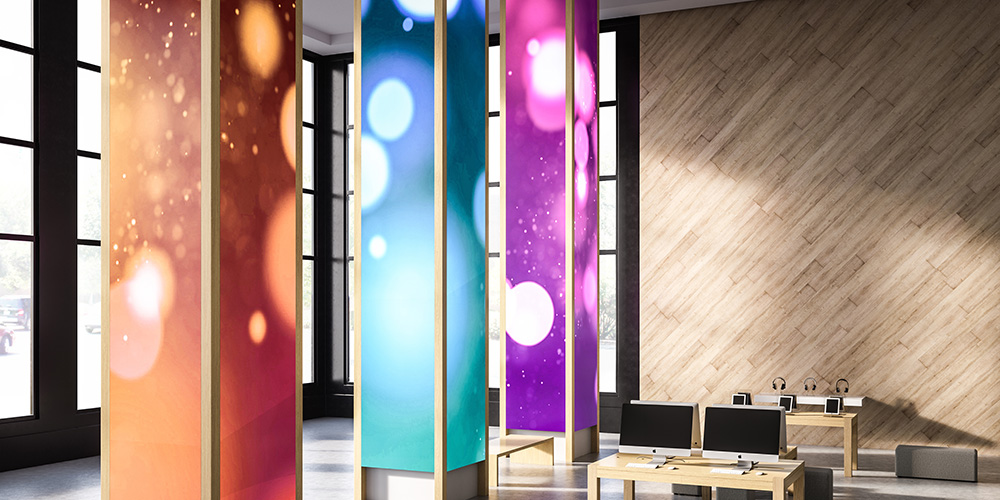The digital-signage landscape is in a constant state of evolution and expansion. AVIXA forecasts that it will be a $44.7 billion industry by 2026 — an increase from $35 billion in 2022. This emphasizes the importance of staying abreast of the trends to align with specific project objectives and effectively manage extensive deployments. In recent years, digital signage has played a pivotal role in addressing a wide range of challenges in the industry, including workforce shortages, facilitating secure office re-entry strategies and optimizing pedestrian flow. The exciting trends include personalization, interactivity, big data and improved experiences.
For many decision makers, it will be the consideration and implementation of technologies that reflect these trends that will increase their confidence in digital signage and the impact it can have.
But, what is digital signage? Beyond the hardware, it’s really a way to connect the organization and its people. Professionals in the AV industry have a role to play by strengthening those bonds through reliable digital signage. This is done by providing systems that deliver consistent and engaging messaging at those points of contact. Some of the key areas where digital signage is picking up considerable traction, where some of the present, unique and exciting use cases are presented in the sections below.
Quick Serve Restaurants (QSR)
Undoubtedly, digital signage for quick-serve restaurants have undergone a dramatic shift. It’s normal now to find digital menu boards. However, as business owners look for ways to not only solve staff shortages, but also exceed customer expectations, digital signage continues to serve as an integral solution. In the QSR application, we see more digitalization and personalization of service via self-service kiosks. These allow customers to place their orders without having to interact with restaurant staff or wait in line. And because everything is done onscreen by the customers, they can be sure the order was entered correctly.
Improving the customer experience even further, there also might be order-status boards, which keep customers apprised of the status of their order. Between in-person, kiosk and ordering ahead by smartphone; QSRs are definitely catering the experience to individual preferences.
Retail
In retail, digital signage plays a different role. Here, it’s all about personalizing the customer’s journey. When customers walk in, they should be given the choice on how to interact with digital signage. That may include speech or touch interactions, or maybe the display provides a code for the customer inspecting the physical product so they can order it from their phone for home delivery. Digital signage is all about providing equity of experience — whatever type of interaction works best for the individual customer.
Another important consideration within retail is efficiency. Power scheduling can help businesses by giving signage a break if a space is consistently empty at certain times. Or, in a convenience store, motion detectors on an individual cooler can tell the digital signage to switch to highlight a specific product that’s available inside to further maximize the sale opportunity.
Corporate
Corporations are facing high real-estate costs and looking to maximize return on any investments. For this reason, businesses are shifting from experiential designs to designs that help them sell the space. Digital signage can help get the most out of spaces by leveraging analytics. When signage is implemented to determine who is using a space, how they are using it and how to manage downtime effectively, it becomes a functional tool.
Integrators can present ways to save costs with digital signage — through energy efficiency, pointed advertising and simply enticing people through the door. In turn, they’ll be well equipped to justify the expense for successful revenue streams. This is amplified even further if the signage is eye-catching enough for visitors to share on social media.
Transportation
Transportation is another notable industry where digital signage plays a major role in operational efficiency. Wayfinding and up-to-date, easily understandable schedules are vital in getting people where they need to be. Airports, especially, present many opportunities for digital signage, from restaurants to retail. One example is a purchasing kiosk with a QR code, which can have a purchase shipped directly to the customer’s home — no need to carry it on or check any bags.
These aren’t the only applications affected by shifting digital-signage trends. There are also arising uses for outdoor, education, large venue, banking, hospitality, fitness, healthcare, houses of worship, manufacturing and much more.
Beyond the Display
Integrators and manufacturers work behind the sign to fulfill the promise of exceptional audience experiences. Once the content and display is worked out, there’s also mounting, storage, connectivity, power and so much more that goes into digital-signage systems. When it comes to solutions, look for manufacturers that are brand agnostic, as they provide greater support of displays and media players across the digital-signage industry. It will also give specifiers the flexibility to change direction or work with the manufacturers they trust most.
Another key element is end-to-end support, whether that’s conducting site surveys, helping to solve mid-project challenges or having a completion celebration. Close connections with manufacturing partners and the AV design community helps avoid potential supply-chain issues, not to mention, it provides a wealth of experience to identify solutions that address project objectives. This is especially true for projects incorporating direct-view LED (DVLED). Valuable resources like rack and videowall design and configuration tools can also help streamline the design and ordering process.
Finally, education will be critical in the digital-signage integration journey. As the industry evolves swiftly, digital-signage courses can help integrators stay ahead of the curve while brushing up on fundamentals that are necessary for any job. Classes on videowall design and installation; display resolution, color space and refresh rates; and connections like HDBaseT and USB Type-C cables can ensure integrators know all there is to know about building and installing the most reliable system.
Reading the Signposts
Digital signage represents one of the strongest growth areas in AV. For this reason, it’s important that integrators understand the ways it’s transforming. There are many diverse applications within restaurants, retail, corporate, and transportation, just to name a few, but really that’s just the tip of the iceberg.
Digital signage presents many opportunities, whether displaying information, improving efficiency, or maximizing returns on investments; it can fundamentally enhance the visitor experience. Manufacturing partners can help integrators stay at the forefront of this new era, providing education, support and of course, great solutions.
Michelle Montazeri serves as director, digital signage for Legrand | AV. She can be reached at [email protected].













